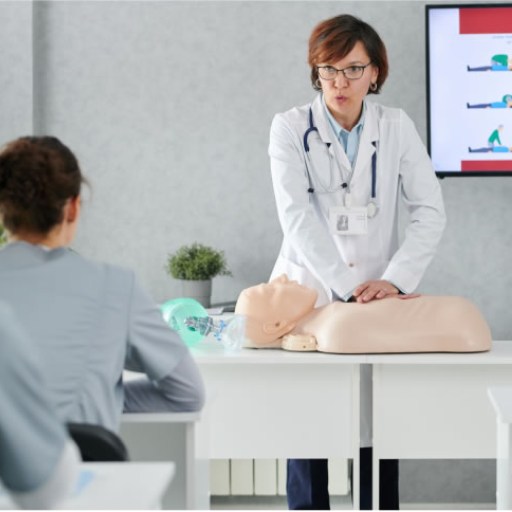
Knowing the correct first aid procedures can potentially save the life of a choking person, as every second is crucial in these situations. Hence, this article focuses on the appropriate steps that must be taken to respond to a choking emergency. It is essential to learn how to correctly identify the root causes of choking, detect the signs indicating a person is choking, and methodically administer first aid using proven techniques, such as abdominal thrusts and back blows. The essay will also highlight and provide considerations for the assistance of adults, children, and infants and outline procedures to follow if one is alone during a choking incident. Ultimately, this article will teach readers how to respond to a choking emergency confidently and efficiently.
What is First Aid for Choking?

The first aid approach to choking focuses on trying to dislodge the object, hindering normal breathing processes, including inhaling or exhaling. A responsive adult or child can employ techniques of abdominal thrusts or the Heimlich maneuver to dislodge the obstruction in the throat. It is better for younger children to execute back blows and chest thrusts due to such anatomy. If the person becomes unresponsive, one may have to perform CP and R, which involve chest compressions. This may flush out the obstruction while ensuring oxygen flow through the body. To achieve maximum effectiveness and safety for both the person exhibiting the signs of choking and the provider of aid, such techniques have to be modified according to the age and condition of the person choking.
Understanding the Signs of Someone Who Is Choking
The very symptoms that indicate said state are happening rather seriously, such as a change in the level of consciousness. Signs to look out for include a person’s voice becoming inaudible, the attempt to speak being impossible due to increased difficulty, and exhibiting wheezing sounds while speaking as a last resort. Lastly, have the person start to cover their mouth with their hands. The person can also not breathe if the blockage to the windpipe is complete. This can happen as severely as turning the person cyanotic blue because of oxygen deprivation. This only intensifies the importance of a speedy response for the person needing aid.
Why Abdominal Thrusts are Crucial in Choking First Aid
Abdominal thrusts, commonly called the Heimlich maneuver, are an efficient emergency method of removing objects lodged within an airway. The procedure works by generating an upward thrust to the diaphragm and abdominal cavity, thereby forcing lap gas from the lungs to obstruct any objects that exceed the mouth.
Key Technical Parameters of Abdominal Thrusts:
- Hand Placement: Place the hands slightly above the navel (umbilicus) but below the sternum, ensuring no pressure is applied to the ribcage or soft lower abdominal area to avoid internal injuries.
- Force Application: Use quick, upward thrusts directed inward and upward, applying sufficient force to create a strong artificial cough while avoiding excessive pressure that may cause damage to internal organs.
- Repetition: Perform thrusts consecutively, checking between each attempt to see if the obstruction has been cleared or if the individual begins breathing again.
- Body Position: For standing or sitting individuals, the rescuer should stand behind the person, ensuring a solid stance for stability while performing the maneuver. For unconscious individuals, similar compressions can be performed with the person lying flat on their back.
By employing this precise technique, abdominal thrusts can rapidly restore airflow, making them an essential component of choking first aid. Proper execution is crucial to ensure safety and effectiveness, underscoring the significance of training in this life-saving procedure.
The Role of Back Blows and Abdominal Thrusts in Clearing the Airway
Both manual thrusts and back slaps serve as an efficient means of dislodging body objects, thus clearing the airway. Abdominal thrusts invoke pressure caused by the diaphragm, which, in turn, creates a force that dislodges the object in question. The individual is then aided by back slaps, which remove any remaining obstructions. Leverage and strikes between the shoulder blades also help expel the blockage as the person is bent forward. Both techniques serve their purpose only if applied accurately;hence, training in these techniques is extremely vital to deal with choking emergencies head-on.
How to Help Someone Who is Choking with Emergency Steps

Evaluate The Scenario
Quickly assess whether the individual is choking by checking for signs where they cannot talk, make ineffective coughs, or have their hands grasping their throat. If they can speak or cough, encourage them to keep coughing to remove the obstruction.
Request Emergency Services
If they still cannot breathe, immediately contact medical services by calling the relevant emergency number, such as 911, or ask someone else nearby to do so. Provide first aid immediately without any further delay.
Give Back Blows
Stand behind the individual suffering from choking before any further complications arise. Get them to lean forward and deliver five forceful blows using the base of your hand to the area between their shoulder blades. Each blow should be sufficiently vigorous so that the obstruction can be expelled.
Perform Abdominal Thrusts
If back blows do not work, stand behind the individual and encircle their waist with your arms. Position your thumb side fist above their stomach right underneath the ribs. Use your other hand and grip your fist. Make sharp and quick upward movements. This should be done for up to five times.
Move Between The Techniques
The combination of 5 back blows and five abdominal thrusts should be conducted uninterrupted until the obstruction is removed or the affected individual passes out.
Should A Person Become Unresponsive
Gently lower the person’s body to the ground and commence CPR while checking the person’s mouth periodically for any obstruction. Continue this process until professional help arrives or until normal breathing is established.
Remember that proper training and practice in these emergency measures are critical to the success rate in tricky scenarios such as choking.
Using the Heimlich Maneuver on Adults
The Heimlich Maneuver is designed to dislodge airway obstructions in a choking adult. Follow these detailed steps to ensure effective application:
- Assess the Situation
Ask the person if they can speak, breathe, or cough to confirm that they are choking. If they are unable to do so, immediate action is required.
- Position Yourself
Stand behind the choking individual, ensuring you are balanced and stable. Wrap your arms around their waist, just above the navel.
- Locate the Correct Hand Placement
Make a fist with one hand and place the thumb side of the fist against the person’s abdomen, slightly above the belly button but below the sternum. This is the optimal position to generate sufficient pressure.
- Perform Abdominal Thrusts
Grasp your fist with your other hand and deliver quick, upward thrusts into the person’s abdomen. The force should be sufficient to dislodge the obstruction but not so excessive that it risks internal injury.
- Force Generated: Approximately 5–10 pounds of force for most adults is recommended, depending on the individual’s size and build. The thrust should target the diaphragm to forcefully expel air from the lungs.
- Repetitions: Continue performing thrusts until the object is expelled or the individual becomes unresponsive.
- If the Person Becomes Unresponsive
Gently lower the person to the floor and initiate CPR if trained. Reassess the airway for obstructions between chest compressions.
By adhering to these precise steps and parameters, proper performance of the Heimlich Maneuver can significantly reduce the likelihood of fatal outcomes in adult choking emergencies.
Adapting First Aid Techniques for Young Children
When performing first aid for young children, it is critical to account for their more minor, more delicate physiology. The techniques must be modified to ensure safety and effectiveness while addressing life-threatening emergencies such as choking.
- Choking - Back Blows and Chest Thrusts
- Back Blows: Position the child face-down along your forearm, with their head lower than their chest. Using the heel of your hand, deliver five firm back blows between the shoulder blades.
- Chest Thrusts (for infants under 1 year): Turn the child onto their back while keeping the head lower than the chest. Place two fingers on the center of the chest, just below the nipple line, and deliver five gentle yet forceful downward thrusts at a compression depth of about 1.5 inches (4 cm).
- Alternate between back blows and chest thrusts until the object is expelled or the child becomes unresponsive.
- If the Child Becomes Unresponsive
- Place the child on a firm surface and initiate CPR if trained to do so:
- Chest Compressions: Use two fingers or the heel of one hand (for larger children) to compress the chest at a depth of 1.5 inches (4 cm) for infants or 2 inches (5 cm) for older children.
- Compress at 100–120 compressions per minute while allowing full recoil after each compression.
- After every 30 compressions, open the airway and provide two rescue breaths, ensuring a visible chest rise with each breath.
- Technical Parameters for Airway Clearance
- Avoid excessive force during back blows or chest thrusts to prevent injury to the ribs or internal organs.
- If an obstruction is visible in the child’s mouth, attempt to remove it carefully using a finger sweep—only if you can see the object.
-
By carefully following these adjusted techniques, caregivers and first responders can effectively manage choking emergencies in young children while minimizing the risk of additional injury. Proper training in pediatric first aid is highly recommended to ensure the confident application of these methods.
Steps to Take if Someone is Choking Alone
- Encourage Forceful Coughing
- If you are choking but can breathe or cough, continue attempting to cough forcefully, as this may expel the object blocking your airway.
- Perform Self-Abdominal Thrusts
- Position your hands into a fist with the thumb side against your upper abdomen, just above the navel and below the ribcage.
- Grasp your fist with your other hand and deliver quick, upward thrusts. Repeat until the object is dislodged.
- Use a Fixed Object
- If self-abdominal thrusts are not effective, bend over a sturdy object—such as the back of a chair or table edge—and press your upper abdomen firmly against it. Apply a sharp, inward, and upward force to replicate the motion of abdominal thrusts.
- Call Emergency Services
- If the blockage persists and you cannot dislodge the object, call emergency services immediately (e.g., 911), even if you cannot speak. Many emergency systems can trace your call location if left open.
Technical Parameters for Self-Abdominal Thrusts and Object Use
- Thrust Location
- To prevent injury, the fist should be placed above the navel but below the ribcage, avoiding the sternum or lower ribs.
- Force Application
- Apply sufficient force during thrusts to generate enough pressure to expel the object but avoid excessive force that could cause internal injury.
- Object Height and Stability
- The fixed object used for thrust assistance should be sturdy and at an appropriate height to apply force effectively to the upper abdomen without overextension.
These steps are based on established first-aid guidelines and should be practiced in a safe and controlled environment to build confidence and preparedness. Even if the object is dislodged, always seek professional medical help after a choking incident to ensure no residual injury has occurred.
When to Call for Emergency Medical Assistance?
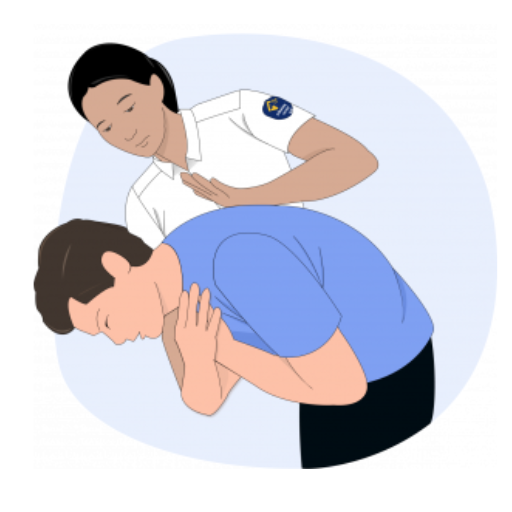
- If the person cannot breathe, speak, or cough, call emergency services immediately, which indicates complete airway obstruction.
- Begin CPR if the person chokes to the point of losing awareness and call for help as soon as possible.
- If the choking object is still lodged in the throat where other signs such as swelling, can’t swallow, or immense pain are present, seek medical assistance.
- Emergency rescue services should be contacted if the individual doubts whether complexity issues related to self-rescue add complications.
Recognizing When a Choking Person Needs More Than First Aid
When evaluating if further medical assistance is needed, it is vital to analyze if aid has improved someone’s condition. Some of the parameters that will give medical professionals insight into when to step in are the following:
Severe Obstruction of the Airway
- If the patient cannot speak, cough, or breathe, immediate action is critical. The patient should be escalated to a higher level of care to dislodge the obstruction.
- If back blows, abdominal thrusts or coughing does not yield any relevant results, immediate action is needed.
SpO₂ Levels Low Oxygen Saturation
- If a pulse oximeter is present, check if the patient is below 92 percent on the device. If so, this is clinically concerning and must be addressed urgently.
Pain within the Chest or the Throat
- If any pain occurs from the airway trauma or any aspiration gets done while in the scope of treatment, that indicates a complication may have developed.
Differences in Cognition Scalars
- Hypoxia can occur, and further medical help is required when the patient exhibits confusion, lethargy, drowsiness, or is nonresponsive.
Entry of External Object within the Airway
- Any obstruction beyond reach will require a medical professional to execute a bronchoscopy or specialized tools to aid in removal.
Failure to appropriately action these indicators will lead to dire situations such as secondary injuries or respiratory failure. In cases such as this, ring emergency services or healthcare professionals. As stated prior, prompt action is crucial.
How to Contact 911 or Your Local Emergency Number for Help
Avoid panicking, but inform 911 or your local emergency services number of the exact issue. This will ensure that responders can reach you swiftly and efficiently. Below are the steps to guide you through the process.
- Call the Number Indicated Above
- Please modify your landline or mobile phone’s country setting for VoIP (Voice over Internet Protocol) services and ensure your registered addresses are with the provider. If you don't, disruptions in location tracking will occur.
- When within the United States, call 911. However, try to validate your country's emergency number before dialing for those outside of America. In Europe, the emergency number is mostly 112, while in certain Asian countries, it is 999.
- Provide Identify Yourself Step-by-Step
- Your exact location is required along with the predetermined set of coordinates. The process is more straightforward in a building or apartment, accompanied by landmarks and cross streets.
- Always ensure your mobile emergency device is set up to allow for the precision of real-time WiFi locations (GPS data). It is typical for mobile device calls to miss out on accurate data.
- State The Nature of The Emergency In A Succinct Manner
- Always provide information about the case, e.g., "We have a medical emergency due to criminal activity and a fire zone." This allows dispatchers to allocate the proper aid effectively and efficiently.
- Be sure to include all relevant information, such as the visible injuries of the many nearby people. Furthermore, state the hazard, which could be a fire or gas leak, or the symptoms, including, but not limited to, difficulty breathing or unconsciousness.
- Abide by the Dispatcher’s Instructions
- Cooperate recognizes Abide. They are experts in aiding individuals through critical processes until aid can arrive. They ask that one be fully compliant, listen to every detail keenly, and respond to questions appropriately to reduce responses.
- Please stay on the call unless told otherwise by the dispatcher, as more context required may be available from the caller.
- SpO₂ Levels:
- If possible, expect and verify oxygen saturation levels and (pulse oximeter values under 92%). If applicable, this indicates critical low oxygen supply levels.
- Check consciousness: Report verbal description of any changes in alertness.
- How long might you characterize these phenomena, for example, choking or unbearable chest pains?
Learning how to report a real emergency is equally important as knowing how to place a phone call. It is crucial to practice accurately communicating what needs to be communicated to the first responders and cooperating with them, especially for those who wish to remain alive. Step further and improve such measures for enhanced safety and quicker response.
What are the Choking Prevention Measures?
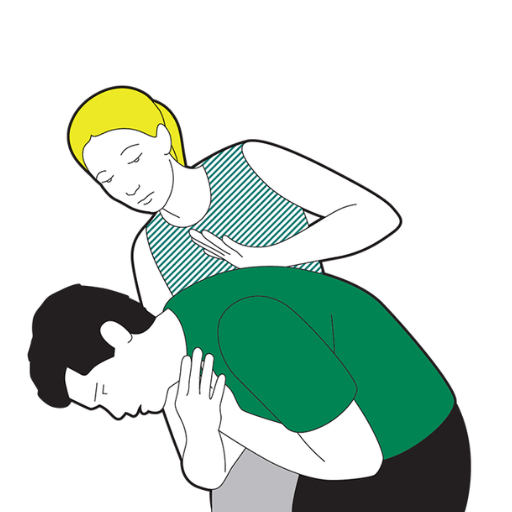
Choking prevention comprises both “pre” and “post” incident actions. Here are some essential focuses:
- Disallowing Supervised Snacking: Allow monitoring while children eat, and ensure they do not place many food items in their mouths. Children should be helped to eat while sitting down.
- Cutting Up Meals: Make it a point to chop the food into bits and pieces when preparing it, especially for young people and kids. Refrain from smashing food like nuts or candies that are round, whole grapes, or whole candy pieces.
- Care with Small Parts: Children should be out of reach of bits and pieces of toys, coins, and other small items that can be swallowed.
- Getting Help: Safe eating rules must be taught, and adults must be instructed on responding to severe choking.
- Other Considerations: If they are elderly or are at risk of not being able to swallow well, make sure that they are on the proper diet and portion for their age group.
By taking these steps, the possibility of choking is minimized to the greatest extent. Everyone is guaranteed a propriety by being saved.
Identifying and Minimizing Risk for Choking
I ensure that food is cut into smaller pieces to minimize the risk of choking for children. Also, I never give toddlers whole grapes, nuts, or steals. Moreover, while children eat, I ensure that there is no laughing or talking so that there are no hiccups for me to worry about during my supervision. Finally, I ensure that no minor children are around small objects like coins or toy parts that can easily be ingested.
In every case, I advise parents on safe eating practices and teach them how to respond when choking, including the Heimlich maneuver. With elderly clients or clients who have dental concerns, I work alongside other health workers to prepare adequate diets and assistance when needed. These tips help make care provision safer by decreasing the risk of choking.
Implementing Choking Prevention Strategies for Young Children
To minimize the risk of choking among young children, several key strategies can be implemented based on expert guidelines and evidence-based practices:
- Food Preparation and Supervision
- Cut food into small, manageable pieces suitable for the child's age. For example, round foods like grapes, cherry tomatoes, and hot dogs should be sliced into thin, half-inch strips or quarters.
- For toddlers, avoid hard, sticky, or round foods, such as whole nuts, popcorn, hard candies, and marshmallows, as these pose higher choking risks.
- Always supervise children during meals and snacks, ensuring they sit upright while eating. Discourage walking, running, laughing, or talking with food in their mouths.
- Toy and Object Safety
- Avoid toys with small, detachable parts or components less than 1.25 inches in diameter and 2.25 inches in length, as these fit within the "small parts test cylinder" used by the Consumer Product Safety Commission (CPSC). Such objects pose a choking hazard if swallowed or inhaled.
- Regularly inspect toys for damage and discard broken ones, as loose parts may become hazardous.
- Environment Management
- Keep hazardous objects, such as coins, buttons, batteries, and small household items, out of children’s reach. Store these items in secure, child-proof locations.
- Educate caregivers and other family members on potential choking risks within the home and outdoors.
- Emergency Preparedness
- Ensure that all caregivers, including parents, babysitters, and teachers, are trained in choking first aid methods, such as the Heimlich maneuver and CPR for infants and children. Training can be obtained through certified organizations like the American Red Cross or American Heart Association.
- Post emergency numbers, including 911, in visible and accessible areas to ensure immediate access during an incident.
- Special Considerations for High-Risk Groups
- For children with swallowing difficulties or developmental delays, consult with pediatricians or speech-language pathologists to assess needs and develop customized feeding and safety plans.
- Use adaptive utensils, if necessary, to assist with safe eating for children with motor challenges.
By adhering to these strategies, the risk of choking incidents in young children can be significantly reduced. These measures require consistent implementation and regular review to ensure maximum effectiveness in protecting young lives.
How Can American Red Cross and First Aid Apps Assist?
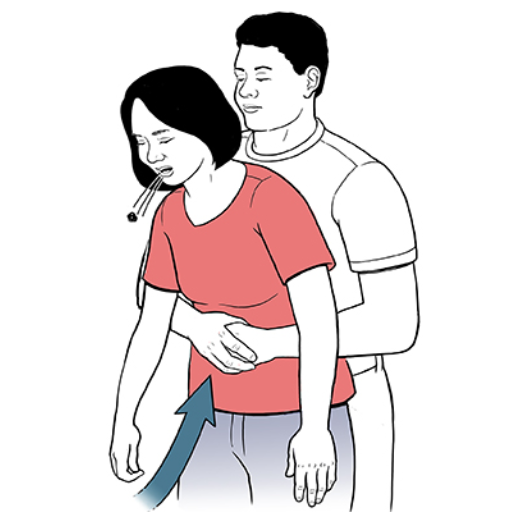
The American Red Cross and First Aid applications supply readily available resources for managing choking cases as well as other medical emergencies. According to the subject's age, these programs provide comprehensive instructions on first aid applications, ranging from CPR to abdominal thrusts. Furthermore, the programs include visual images, videos, and step-by-step strategies for the patient's caregivers to ensure the correct procedures are followed before assisting the patient. In addition, this technology can also notify users of first-aid training classes that may be within their immediate vicinity, thus encouraging training and preparedness. From the design perspective, many people find it easy to use and navigate, ensuring that it is accessible during emergencies to provide crucial information in the shortest time possible.
Benefits of American Red Cross Training in Choking First Aid
Participating in American Red Cross training provides individuals with critical skills for managing choking emergencies effectively. These courses are designed to meet rigorous safety and medical standards, such as those outlined by the American Heart Association (AHA) and the International Liaison Committee on Resuscitation (ILCOR). Key benefits include:
- Hands-On Practice
Participants engage in practical exercises, such as performing abdominal thrusts (Heimlich maneuver) and back blows, under the supervision of certified instructors. This ensures the accurate application of techniques in high-pressure situations.
- Age-Specific Protocols
The training covers unique protocols for different age groups, including infants, children, and adults. For example:
- Infants: Back slaps combined with chest thrusts.
- Adults: Abdominal thrusts as the primary intervention method.
- Real-Time Feedback
The program utilizes advanced mannequins that provide real-time feedback on technique accuracy, ensuring proper force and positioning during practice.
- Recognition of Medical Indicators
Trainees learn to recognize signs of partial vs. complete airway obstruction and the physiological parameters impacted by choking, such as oxygen saturation and airway patency.
- Certification and Continuous Learning
Upon successful completion, participants receive a two-year certification. They can also continue to be educated and recertified to stay updated on best practices.
By combining evidence-based instruction with hands-on experience, American Red Cross training equips individuals with the confidence and technical expertise to save lives during choking emergencies.
Utilizing a First Aid App for Immediate Guidance
First aid apps guarantee quick access to information and proper guidance in life-saving procedures during choking. Ensuring that users have access to colorful images, user-friendly interfaces, and audio instructions makes these applications easy to use. Besides these functions, many other tools are available, such as quick emergency numbers and handy tips for different age groups, particularly young children and elderly people. All these features make it easy to take emergency action in case medical help is delayed.
References
- Mayo Clinic: Choking First Aid
- Red Cross: Adult & Child Choking First Aid
- Johns Hopkins Medicine: Choking First Aid and Prevention
Frequently Asked Questions (FAQ)
Q: What are the first steps to take when someone is choking?
A: When someone is choking, performing first aid as quickly as possible is essential. Start by assessing if the person can cough or speak. If not, they may have a complete blockage. Encourage them to cough forcefully to try and dislodge the foreign object.Q: How do you perform the Heimlich maneuver on adults and children?
A: To perform the Heimlich maneuver, also called abdominal thrusts, stand behind the person and wrap your arms around their waist. Make a fist with one hand and place it slightly above the navel. Grasp the fist with your other hand and perform quick, upward thrusts, five times if necessary, to dislodge the blockage.Q: What should I do if I am alone and choking?
A: If you are alone and choking, try to perform abdominal thrusts on yourself. Use a firm object like the back of a chair to press into your abdomen, or make a fist and perform upward thrusts against your own body to try to remove the stuck object.Q: How should first aid be provided if the person becomes unconscious?
A: If the person becomes unconscious, call emergency services immediately and begin CPR if you are trained. Start with chest compressions, as used in CPR, to try and dislodge the blockage and restore oxygen to the brain.Q: What adjustments should be made for choking infants?
A: Do not use the Heimlich maneuver for infants under one year. Instead, support the infant's head and neck, keeping the head lower than the trunk. Give five back blows with the heel of your hand between the infant's shoulder blades, followed by five chest thrusts.Q: How can I help if someone else is choking and I'm not trained in first aid?
A: Even without formal training, you can help by encouraging the person to cough and calling for emergency assistance. If comfortable, follow the basic steps of the Heimlich maneuver and stay with the person until help arrives.Q: What are some common causes of choking in young children?
A: Young children often choke on small objects or pieces of food. It's crucial to keep such items out of reach and ensure children eat slowly and chew their food thoroughly.Q: Why is it important to stay updated with first-aid techniques?
A: Staying current with first-aid techniques ensures you can provide adequate aid in emergencies. Guidelines may change, and regular refreshers can improve your confidence and ability to act quickly during life-threatening situations like choking.Q: What role does CPR play in choking emergencies?
A: CPR is vital if the person becomes unconscious due to choking. It involves chest compressions to maintain blood flow and provide oxygen to the brain while attempting to clear the windpipe. It is a crucial step in emergency medicine when choking occurs.

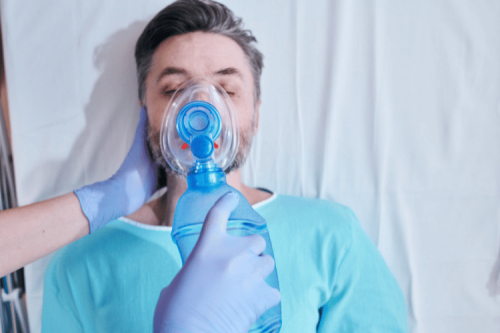
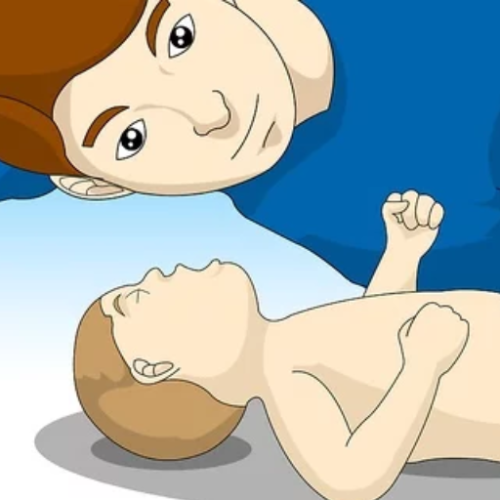


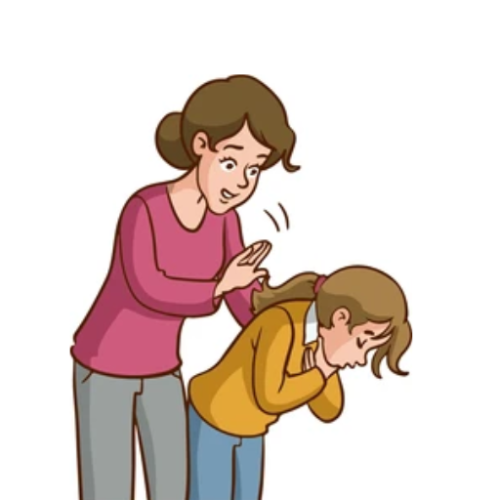
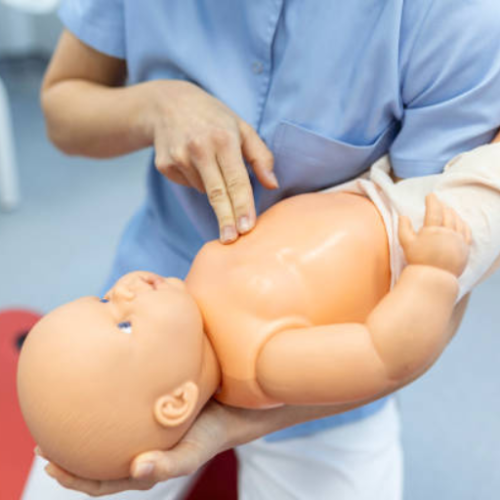
 Login with Google
Login with Google Login with Facebook
Login with Facebook